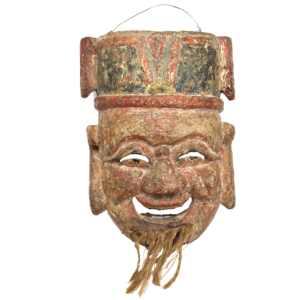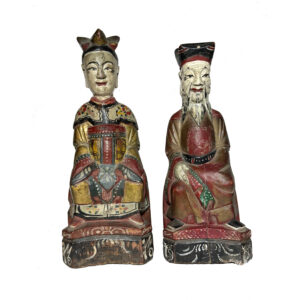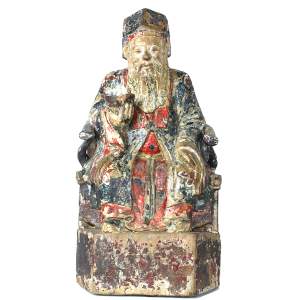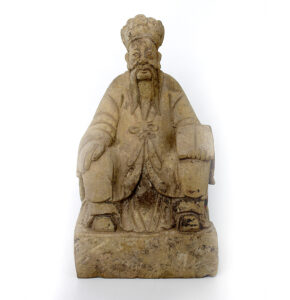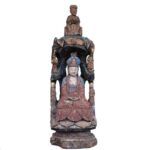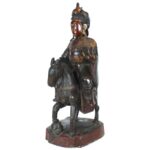Tudi Gong: The Taoist and Popular Religion Earth God
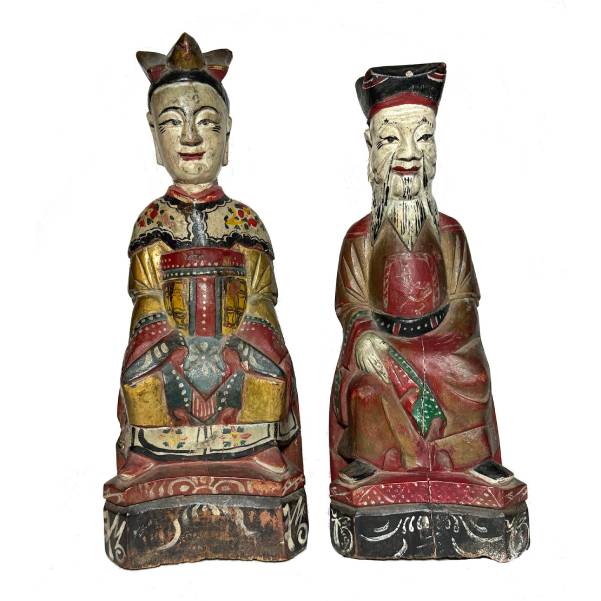
Followers of Taoism and Chinese Popular Folk Religion believe the cosmos consists of three domains: Heaven (the Celestial Domain), Earth, and the Underworld with each domain being inhabited by a conglomeration of significant gods and goddesses. The Jade Emperor (the Ruler of Heaven), presided over the Celestial domain and, in turn, ruled a network of local House and City Gods. The most significant and ubiquitous Earth gods are the Kitchen God who presides over individual households, and Tudi Gong, the “Earth God” who is guardian of local villages and communities.
Tudi Gong is also often referred to as the “Land God,” “Lord of Land,” “Land Master,” “Land Divinity,” “Local God of the Land,” or “Village God.” A subordinate of the City God, he is the lowest-ranking deity in the Taoist and Popular Folk Religion pantheons, but he is one of the most-widely worshipped earth deities among the Chinese. Historically, every provincial village and local community had its own unique and distinct Earth God, who was unlike the next village’s Earth God. Differing forms of the Earth God were not seen as manifestations of a single Earth God in Heaven; rather, they were thought of as individualized deities who actively lived amongst and interacted with human beings in the communities they protected.
Dedications to Tudi Gong began in ancient China when the country was almost exclusively reliant on agriculture and land was highly regarded as the primary source of food, shelter, and clothing. In earliest times, the land deity was symbolically represented as a pile of earth, honored by landowners who performed offerings and dedicated devotional rituals to him. This symbolism for land god was represented by the Chinese character “tu” (earth, land) shaped like a pile of earth on the ground, from which Tudi Gong’s name evolved.
Tudi Gong’s popularity stems from his position as a local city deity to whom villagers could turn for help in times of crisis, including drought or famine; who protected small villages; and who controlled the prosperity and fortune of common people. Small temples or shrines dedicated to him and sometimes including his wife Tudi Po were generally placed adjacent to farms so farmers could pray for a plentiful harvest that would be able to be sold at market. They were also often built near rivers and water sources so that Tudi Gong and farmers would be assured that the wealth he provided wouldn’t be wasted by letting it run elsewhere. Farmers, businessmen, shopkeepers, and homemakers would seek his help on a daily basis inform him about important events in their lives and their communities. He was consulted about the time to begin agricultural tasks and was recognized as a benevolent and responsive god with a celebration when they were completed. Most households included an altar or shrine with an image Tudi Gong, and temples of all sizes dedicated to him were built throughout both rural and urban China.
Earth Gods, like Kitchen Gods, were sometimes represented as a married couple, reinforcing the idea that the gods of the Earthly Domain strongly resembled and closely interacted with human beings. Following Popular Folk tradition Tudi Di Gong is sometimes affectionately referred to as “Land Grandpa,” and Tudi Po as “Land Grandma” or “Land Granny.” In rural areas it is more common to have Tudi Gong placed next to Tudi Po on an altar or in a village Tudi Gong temple. In the past when China and Taiwan were more agriculture based economies, villagers would regularly visit the local Tudi Gong Temple and leave offerings of fruit on an altar in front of a statue of him, and, in an exchange, take home a piece of fruit left by other villagers. Eating the fruit was believed to be propitious, and by doing this one was eating “Tudi luck.” When Tudi Gong was accompanied Tudi Po villagers made more frequent and personalized offerings
In more recent times, the food exchanges have been replaced by money exchanges. Temple attendees would place a money offering into a small box next to a Tudi statue and take out the equivalent donation by another as an exchange of “Tudi Gong money” considered a wish for good luck.
Tudi Gong is generally portrayed as a benign and friendly looking old man with gray hair and snowy white voluminous three-part beard extending almost to his waist. As a recognized official he traditionally wears a high square black hat, a long robe with long sleeves elegantly flowing over his knees and, a bright red undergarment, a sign of “fu” for good luck with which he is associated. He sits on a throne or horseshoe chair holding a “boat” shaped tael (or ingot representing the wish for wealth), in one hand and the other hand either grasps a wooden staff or is placed firmly on his knee in the position of an official. Depictions of Tudi Po have varied over the centuries and in different locations. Initially portrayed as a young beautiful woman in recent years she has often been displayed as an older woman seated with the flowing robes as if she were an official’s wife.
Published Sources:
Alessandro Dell’Orto, Place and Spirit in Taiwan: Tudi Gong in the Stories, Strategies and Memories of Everyday Life, New York, Routledge Curzon, 2002.
Stephan Feuchtwang, Popular Religion in China: The Imperial Metaphor, London, Routledge Curzon, 2001.
Ronald Knapp, China’s Living Houses: Folk Beliefs, Symbols, and Household Ornamentation, Hawaii, University of Hawaii Press, 1999.
Cheng Manchao, The Origin of Chinese Deities, Beijing, Foreign Languages Press, 1997.
Keith Stevens, Chinese Mythological Gods, New York, Oxford University Press, 1991.
Online Sources:
Cultural China, Traditions, Myths and Legends: The God of Land,
Nationmaster.com, Encyclopedia: Tu Di Gong,

